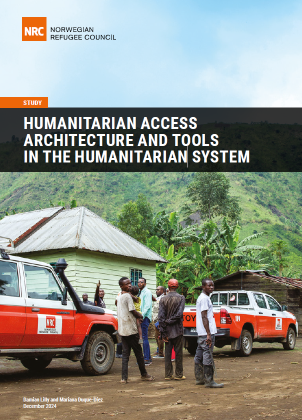Download Resources - English
Humanitarian access architecture and tools in the humanitarian system
Humanitarian access is central to any humanitarian response. Given the growing humanitarian needs in increasingly challenging operational environments and the significant decrease in funding for humanitarian action requires an efficient and principled approach to overcome the main impediments delaying or blocking humanitarian responses. Considering these developments humanitarian access has become a pressing priority for the humanitarian system in recent years, leading to the establishment of structures, frameworks, mechanisms, strategies, approaches, tools and products intended to increase leadership on the issue.
This study sought to reflect on the progress that has been made in this regard to identify areas that continue to frustrate efforts to achieve better humanitarian access. Most of the stakeholders remarked that while progress had been achieved it was not possible to conclude that the current humanitarian access architecture and tools are fit for purpose.
Some of the report’s findings highlighted:
- The lack of confidence in and accountability within access coordination mechanisms mean the issue tends to be dealt with as a technical matter rather than a strategic priority under the leadership of the Humanitarian Coordinator.
- Humanitarian Country Team access strategies could be made more actionable, while access could also be more fully integrated into the humanitarian programme cycle.
- Access monitoring, reporting and analysis systems are sufficient but hampered by a lack of trust that limits information sharing and an overly focus on organisational access barriers.
- A lack of humanitarian leadership and support for principled humanitarian action are the main barriers to better collective advocacy, diplomacy, and negotiations.
- Policy advice and tools on humanitarian access are considered useful but often involve laborious processes, and there is limited accountability for their implementation.
The report’s findings and recommendations are being released at a time of great change within the humanitarian sector. The dramatic reduction in US donor funding compounded by the announcement of further reduction of funding from other traditional donors is forcing the re-imagination of the humanitarian sector in a time of ever-growing numbers and scale of humanitarian crises. While the restructuring process is still ongoing, it is already clear that humanitarian operations will need to be much more targeted, coordinated and efficient to compensate for the loss of resources and capacity. The humanitarian community will subsequently need to give greater focus to delivering assistance to populations with the highest needs, who are most often situated in Hard-To-Reach areas.
Addressing the greatest needs represents the unique value and the core mandate of humanitarian actors. It will not be without its challenges though.
One challenge to achieving this will be how ‘we’ better collectively address the humanitarian access barriers that often limit humanitarians’ ability to reach those most in need. The report’s conclusion that the current humanitarian access architecture and tools are not fit for purpose is likely even more relevant, and more pressing, in 2025 compared to when the research was undertaken in 2024.
It is an opportune time then to take forward the report’s recommendations, adapt them in places to the new funding environment, and make a renewed effort to share resources and work jointly to ensure the humanitarian architecture and tools are enabling the humanitarian response where it is needed the most.
